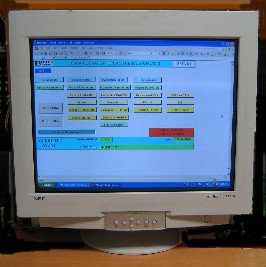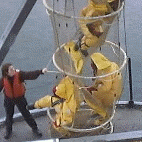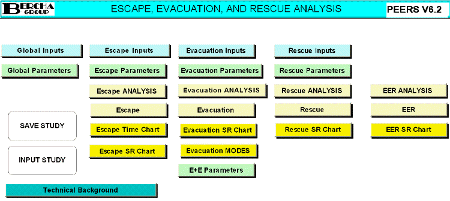|
Consulting Services Since 1975 |
Software Probabilistic Escape, Evacuation, and Rescue Simulation (PEERS) |
|
|
|
Site Navigation |
|
||
|
Software Quick Links
|
The Bercha Probabilistic Escape, Evacuation, and Rescue Simulation (PEERS) software system is a state of art EER modeling package capable of simulating the EER process for a variety of fixed and mobile installations for a range of ocean conditions from Arctic ice and icebergs, through moderate open water, to tropical storm conditions. The simulator is capable of providing either deterministic expected or worst case estimates or a full probabilistic output utilizing a Monte Carlo sub-module integrated into the PEERS system. Schematically shown in Figure 1, the PEERS model is subdivided into several principal modules. The EER process has modules as follows: |
||
|
Escape: |
The movement of personnel from their location at the time of the alarm or accident alert to a safe temporary safe refuge (TSR). |
|
|
|
Evacuation: |
The movement of personnel from the TSR to a safety craft such as a TEMPSC, launching of the TEMPSC to the ocean (or ice) surface, and successful separation of the TEMPSC from the installation to a location sufficiently distant to avoid any installation accident effects. |
||
|
Rescue: |
The successful transfer of personnel from the TEMPSC or other safety craft to a safe haven such as a standby vessel, passing vessel, rescue helicopter, or land. |
||
|
There is generally an
important interaction between the EER process and the accident effects,
as illustrated in Figure 2 for a typical platform escape route system,
and with the environment, particularly severe environments such as
extreme weather or arctic ice and iceberg conditions. PEERS is capable
of modeling the interactions of the environment both on a technological
level and an operational level. Specialized technologies such as ice
resistant life craft illustrated in Figure 3 can be incorporated in the
model for the evacuation and rescue process. Event trees such as that
shown in Figure 4 are capable of taking into account the variability and
severity of different ice conditions, while alternate event tree
approaches can take into account different evacuation modes for
different severities of weather conditions. Integrated results
considering accident scenarios, weather and ice probabilities, and
relative success rates of different evacuation and rescue modes provide
an integrated assessment of the overall EER system capability for any
given installation as illustrated in Figure 5. (Click on the
thumbnails below to view the image). |
|||
|
|
|||
| [About Us] [Services] [Projects] [Photo Gallery] [Publications] [Software] [Links] [Contact Us] | |||
|
This page and all contents are Copyright © Bercha Engineering Limited. |
|||








